Overview
What is this tool?
ETO's Map of Science collects and organizes the world’s research literature, revealing trends at the cutting edge of science and technology. The Map organizes hundreds of millions of articles from around the world into over 85,000 clusters, or groups of articles that cite each other often - typically because they share other things in common, such as topic or language. (Learn more about research clusters.) The Map also includes data about each cluster’s growth over time and about the key topics, countries, authors, and funders of the articles within the cluster.
What can I use it for?
You can use the Map to:
- Track publication output, growth, and other trends across different research topics, whether general or specific. The Map’s filters can help you discover and analyze clusters of research about highly precise concepts - everything from robots that grow like vines to speech recognition in noisy environments.
- Learn about key countries, researchers, organizations, articles, and concepts in different areas of research.
- Identify the research areas with the fastest growth, largest influence, and other measures of impact.
- Build powerful, complex filter combinations with the Map’s easy-to-use interface to quickly zero in on the most relevant topics and actors.
Get updates
What are its most important limitations?
- The Map isn’t built for researching individual people or articles. It’s better to look first for particular types of research or research organizations using the Map’s filters, then browse information about the people and articles related to that research - not the other way around. Read more >>
- The Map’s clusters don’t always have a clear meaning. The research clusters in the Map are generated algorithmically using the citation links between articles. In some cases, this method may group articles that don’t have much in common thematically. In most cases, though, studying a cluster will usually show common-sense reasons why the articles in it tend to cite each other (for example, they may share the same language or subject matter). Read more >>
- The Map shows a single point in time. The research clusters displayed in the Map come from ETO’s Research Cluster Dataset, which doesn’t include any information about how individual clusters or fields of research have changed over time, other than some basic growth statistics. Because of this, the Map only gives a "snapshot" view of the research landscape.
- Cluster metadata are incomplete for recent years. It takes time for our data sources to incorporate the latest publications and metadata. The Map reflects this lag. Read more >>
- The Map doesn’t cover unpublished research. Its data sources only include research that has been publicly released. We believe these sources cover a significant fraction of publicly released research worldwide (and in particular, the large majority of published research in English), but we have no way of knowing how much unpublished research exists, or how different it would look if unpublished research were somehow included. More details >>
- The Map’s coverage of Chinese research is incomplete. Many Chinese publications are only available in China-based journals that are not included in the Map’s data sources. Use particular caution when interpreting data from the Map related to Chinese research organizations, funders, or authors.
- Some features are missing or limited in mobile. For the full version of the Map, we recommend using a desktop browser.
For more caveats about the data used in the Map, refer to the documentation for the source datasets.
What are its sources?
The Map of Science relies on ETO’s Merged Academic Corpus and Research Cluster Dataset. Read more >>
Does it contain sensitive information, such as personally identifiable information?
No, other than the names of some researchers (all taken from public documents).
What are the terms of use?
The Map of Science is subject to ETO’s general terms of use. If you use the tool in your work, please cite us. The underlying datasets are not publicly available due to licensing restrictions.
How do I cite it?
Please cite "ETO Map of Science" and include a link to the tool.
Using the Map
How do I use it?
Viewing the Map
The Map of Science tool has four different views:
-
Map view, which is the default for the desktop version. Map view isn’t available on mobile devices.
-
List view, which is the default on mobile.
-
Summary view, which summarizes displayed clusters when filters are applied.
-
Cluster detail view, which can be opened by clicking on a specific cluster in the map view or list view.
Map view
If you’re using a desktop browser, opening the Map will bring you here first. This view is built around a visualization of over 85,000 research clusters, each represented by a single dot on the Map. Clusters spaced closer together have more inter-cluster citation links (that is, citations by articles in one cluster to articles in the other). The color of each dot indicates the most common general research field (for example, biology, social sciences, or medicine) among articles in the cluster from the last five years; larger dots represent clusters with more papers added in the past five years.
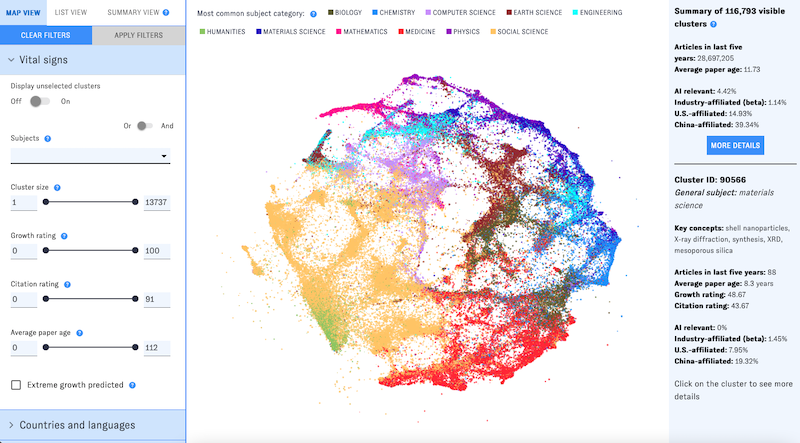
To winnow down the Map, use the left-hand filter menu. Hover over the "?" icons to learn more about what each filter means.
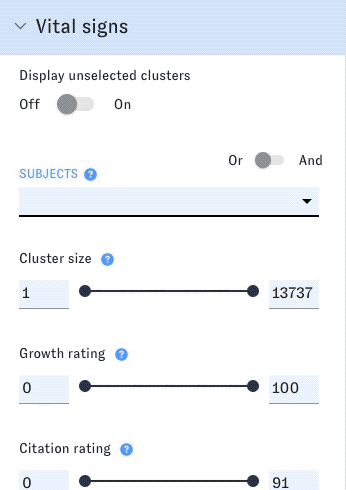
As you work with filters, click the "Apply filters" button to apply them. Clusters that don’t match the filters will disappear from the Map, which will automatically rescale around the ones that remain. If you’d prefer to keep all of the clusters visible, use the "Display Unselected" switch.
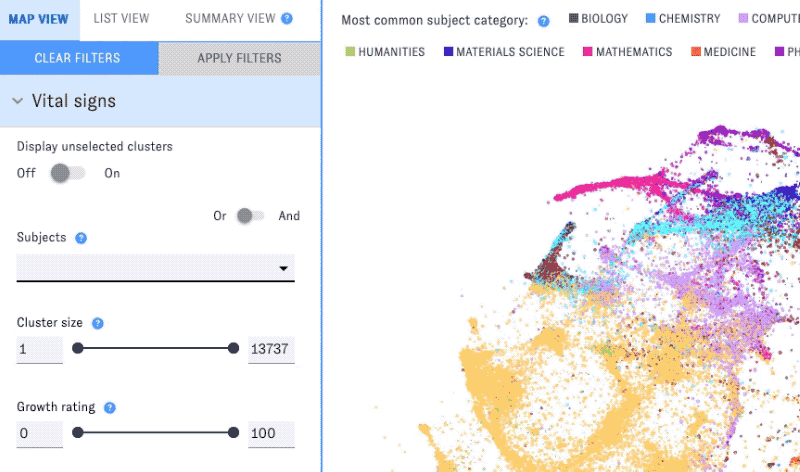
On the right side of the Map, you'll see summary information for all clusters meeting the current set of filters. If you hover over an individual cluster, summary details for that cluster will also appear in the right-hand pane. Click the "More details" button to jump to summary view, or click on an individual cluster to bring up its detail view.
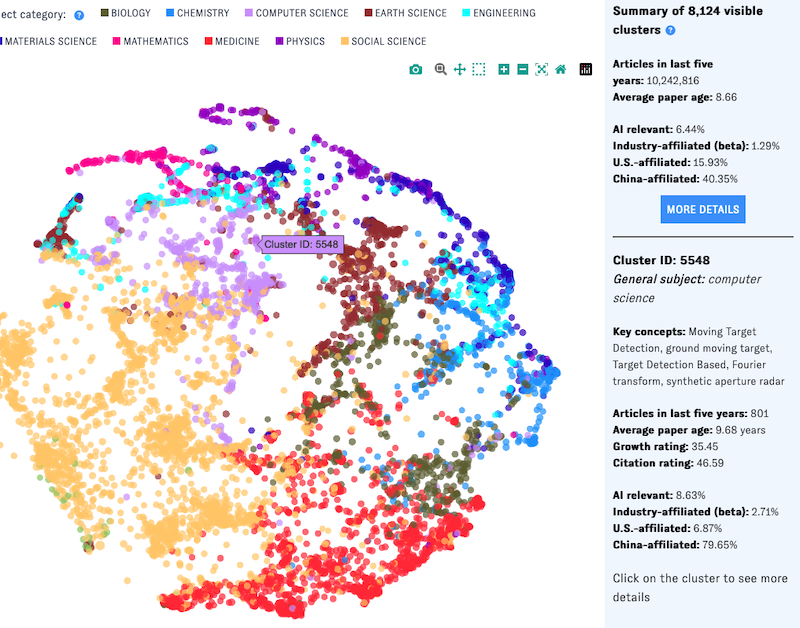
Click and drag to zoom in on a portion of the Map. To access more controls, navigate to the top right corner of the window.
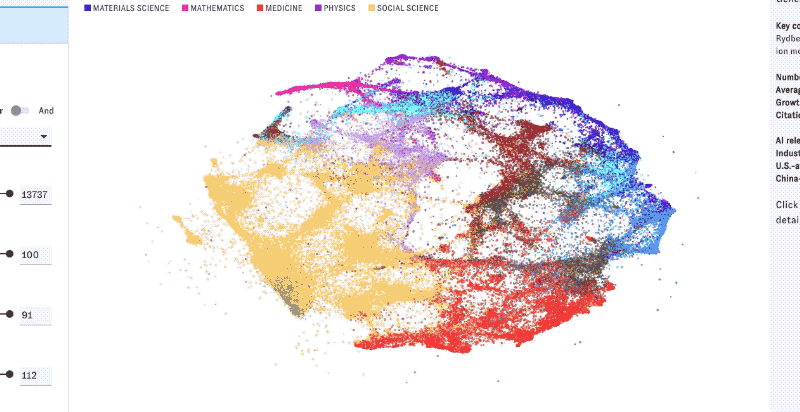
List view
The list view shows each cluster as a row in a table. Use the left-hand filter pane to narrow the table to clusters that meet your filters. To learn more about what the filters mean, hover over the "?" icons.
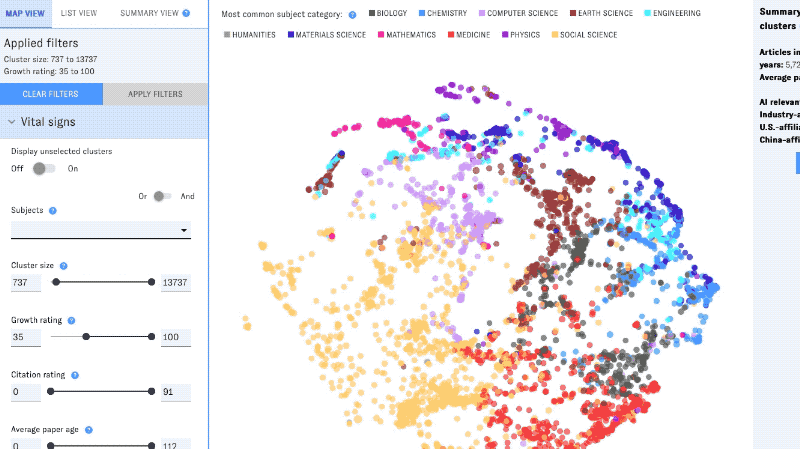
You can add or remove columns with the "Add/Remove Columns" button. Most of the available filters can also be displayed as columns.
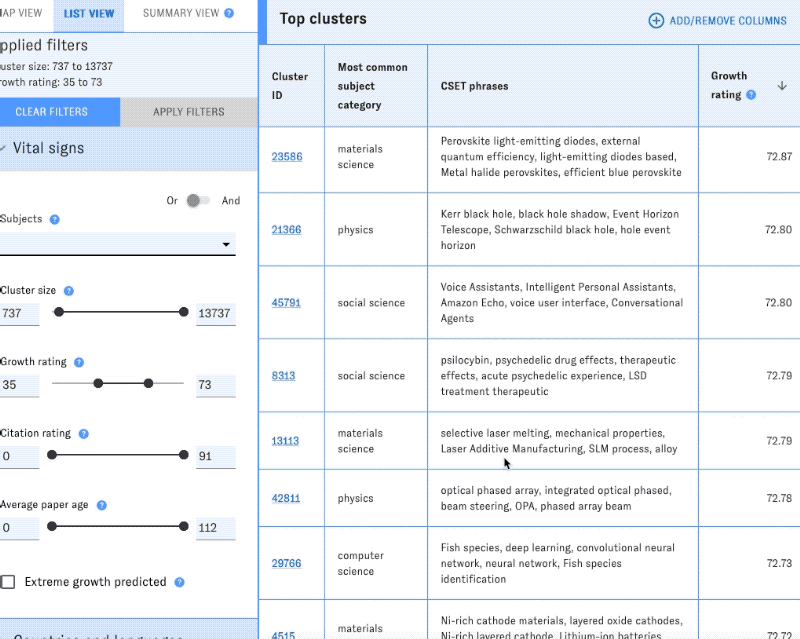
By default, the clusters are listed in descending order by cluster size. You can reorder the table by any column with an arrow icon in ascending or descending order.
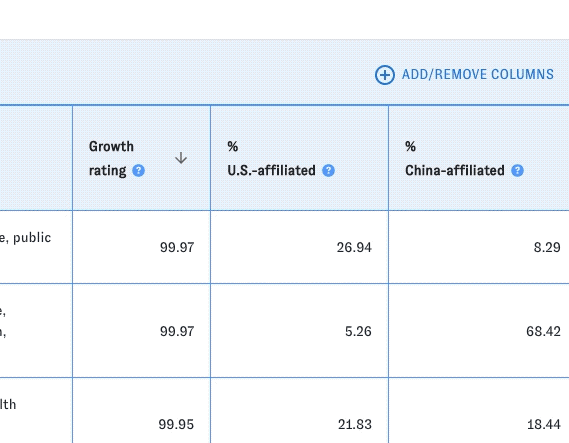
Click on a cluster to bring up its detail view.
Summary view
As you filter the Map, summary view will show you aggregated information about the group of clusters that meet the filters you've applied, such as growth, concepts, languages, prominent articles, and countries. (Here, and generally in ETO resources, we use "country" informally, as a shorthand term for sovereign countries, independent states, and certain other geographic entities. Read more >>)
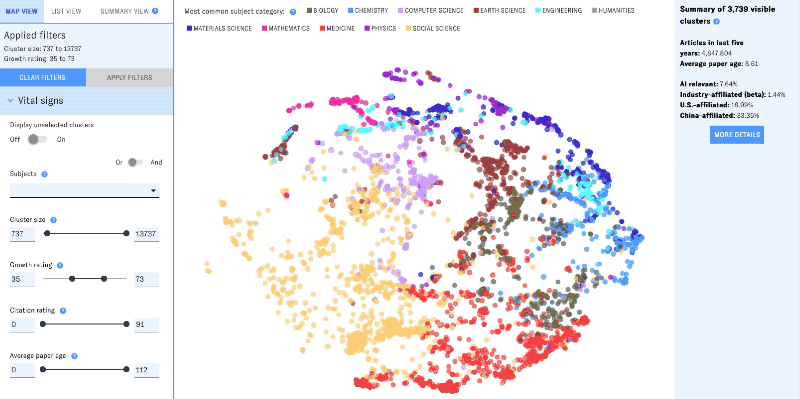
Cluster detail view
The cluster detail view is structured similarly to the summary view and includes similar information, but is focused on the specific cluster you've selected (rather than all of the clusters that meet specified filters). Compared to the summary view, the cluster detail view also includes some extra data relevant only to individual clusters, such as cluster-level growth prediction and citations to and from other clusters.
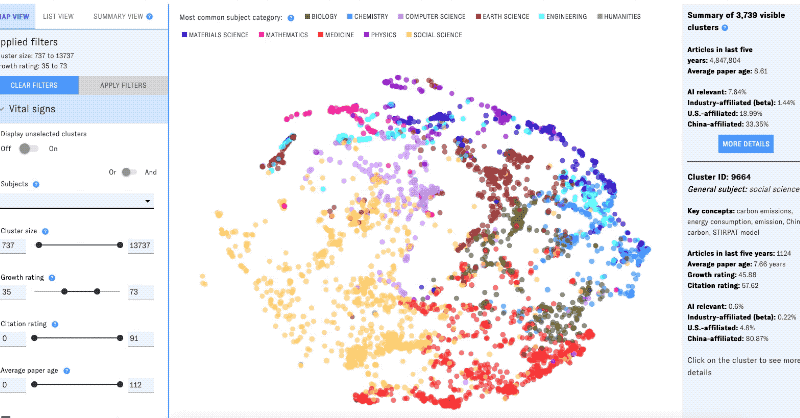
Exporting data
Export is currently available from list view only. After building a query using the Map's filters and customizing your results in list view, just click to download cluster metadata in csv format.
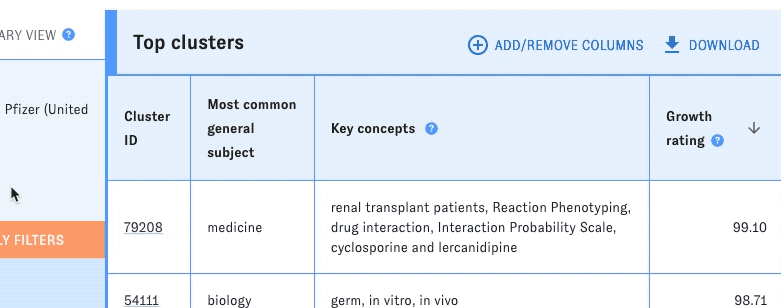
Returning to a specific page
As you use the Map of Science, your browser’s address bar will update to reflect the view and filters you've selected. At any time, copy the URL from the address bar to return to the same page later.
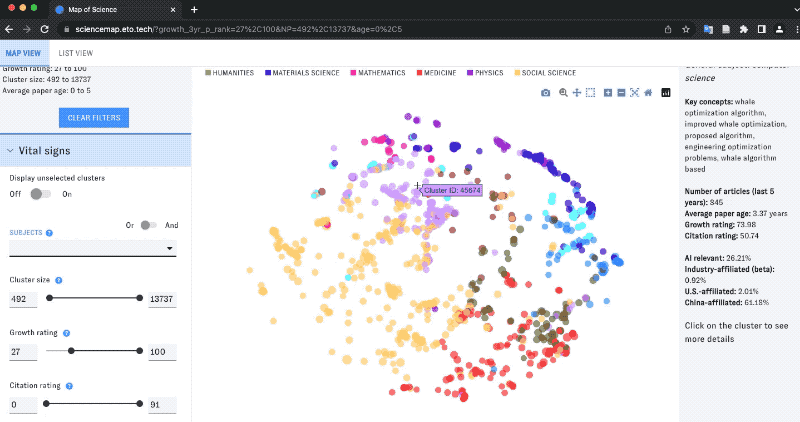
What can I use it for?
Explore research on any topic, from the general to the very specific. The Map includes filters for hundreds of high-level concepts and fields of study. Tinkering with these filters can lead you to clusters of research about highly precise concepts - everything from robots that grow like vines to speech recognition in noisy environments.
Show me research...
- ...about computer science.
- ...about speech recognition.
- ...about aqueous zinc-ion batteries.
- ...that's highly related to AI safety.
Learn about the key countries, researchers, organizations, and articles in specific areas of research using the Map’s browse and detail view modes.
- What are some especially important recent articles about computer vision?
- Which countries and organizations play the biggest role in leading-edge medical research?
- What are some rapidly growing areas of research where Indonesian researchers play a leading role? What about Argentina, Germany, or Nigeria?
- Show me areas of research activity for Georgetown University, the University of Florida, Tsinghua University, Pfizer, IBM, or Oak Ridge National Laboratory.
- What are some examples of research areas funded by the National Institutes of Health? How about Fujian Province in China, or the Gordon and Betty Moore Foundation?
Identify the research topics with the fastest growth, most citations, and other measures of impact.
- Which research topics related to computer science are growing the fastest worldwide? What about in China?
- Which types of robotics research are most cited?
- Show me the very fastest-growing areas of research within inorganic chemistry. Which universities lead in these areas?
Build complex, detailed queries using combinations of filters to quickly zero in on the most relevant topics and actors.
- Show me research that’s AI-focused, growing quickly, and highly cited in patents.
- What are some key trends in areas of research where Chinese companies are highly active?
- Show me areas of research where German researchers and American researchers are both highly active.
- Show me fast-growing, AI safety-related clusters where Chinese researchers are active.
How have others used it?
Researchers at CSET and elsewhere have used the Map to:
- Identify prominent countries, researchers, and subtopics within specific fields of research, such as trustworthy AI, superconductor electronics, and bioinformatics.
- Develop a general method for understanding emerging technologies and their supply chains.
- Track research interest across specific topics in materials science, such as actuators and morphing.
- Explore how AI research priorities differ between top researchers in the U.S. and China.
- Identify the leading countries in overall research output and in specific topics, such as medicine, physics, and computer science.
Beyond these public examples, users in and out of government consult the Map in decisions related to science and technology policy, diplomacy, industrial policy, national security, and other domains.
We’ll add new public examples here as we learn about them.
Which uses are not recommended?
Researching individual people or articles. You can’t search the Map for individual people or articles. The Map does include some of this information in the detail view for each cluster, to provide context to that cluster, but in order to view it, you have to have first selected that cluster for other reasons (for example, because it meets criteria you specify with filters). In other words, it’s better to first look for particular types of research or research organizations using the Map’s filters, then browse information about the people and articles related to that research - not the other way around.
Tracking trends over time in the composition of a specific field or cluster of research. The Map provides a current "snapshot in time" of research. You can see which fields have grown fastest overall (as of the time of that snapshot) using the Map’s growth filters, but you can’t currently see how an area of research has evolved over time in terms of participants or funders (for example). It may be possible to approximate some such analyses with careful combinations of filters and cluster details, but the Map isn’t currently designed to support these analyses.
Studying topics unlikely to show up in public literature, such as classified government research or commercially sensitive R&D. The Map relies entirely on public documents, such as published articles, preprints, and conference papers and may not give a good view of other, non-public types of research.
Drawing definitive conclusions about Chinese research trends. Because the data sources for the Map omit many Chinese-language publications, you should use particular caution when interpreting data from the Map related to Chinese research organizations, funders, or authors.
Drawing definitive conclusions about very recent trends. The data sources behind the Map's cluster metadata have a significant lag. Be cautious when interpreting metadata from recent years.
Sources and methodology
All of the data used to generate the Map of Science comes directly from the Research Cluster Dataset, which is itself based on the Merged Academic Corpus. These datasets aren’t publicly available, but you can learn more about them on their documentation pages:
- The Research Cluster Dataset uses data from our Merged Academic Corpus to create over 85,000 citation-based clusters of articles and generates extensive metadata about each one, including cluster growth, language, subject matter, funding, and other topics. All of the visualization, filtering, and other features in the Map of Science use the cluster-level metadata in the Research Cluster Dataset. To understand the "back story" behind a particular Map of Science feature or filter, refer to the relevant part of the Research Cluster Dataset metadata documentation.
- The Merged Academic Corpus (MAC) contains detailed information on over 260 million scholarly articles, combining data from public and private sources to achieve an unmatched view of the global research literature. The article-level metadata in the MAC is used to build and characterize clusters in the Research Cluster Dataset, meaning that the Map of Science (which relies on the Research Cluster Dataset) is indirectly based on the MAC.
Look for tooltips throughout the Map's interface for details on how these data sources are being used.
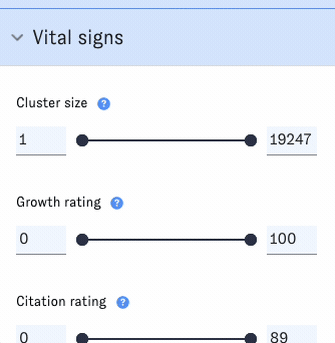
How subject search works
As you type into the Map's "Subjects" field, you'll be prompted with options identified as "research fields," "research subfields," and "concepts."
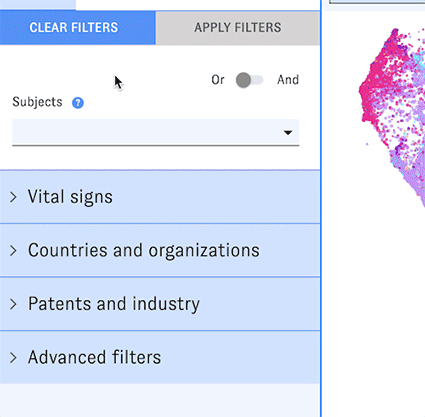
Generally speaking, selecting options from this menu will return clusters containing high proportions of relevant articles. For example, picking "biochemistry" returns clusters with lots of biochemistry articles in them.
Exactly how this works depends on whether the option you've selected is a "research field," a "research subfield," or a "concept." These three option types incorporate different data from the Research Cluster Dataset:
- Research fields correspond to the research field concept in the Research Cluster Dataset. Filtering by a research field will return all clusters assigned to the that field. To learn how clusters are assigned to fields, see the Research Cluster Dataset documentation.
- Research subfields include:
- Research subfields in the Research Cluster Dataset. In most cases, filtering by a research subfield will return all clusters assigned to the corresponding subfield. To learn how clusters are assigned to specific subfields, see the Research Cluster Dataset documentation.
- Emerging technology topics in the Research Cluster Dataset. The research subfields Artificial intelligence, Computer vision, Natural language processing, Robotics, AI safety, Cybersecurity, Large language models, and Chip design and fabrication correspond to emerging technology topics in the Merged Academic Corpus. Filtering by any of these subfields will return all clusters where 10% or more of the articles in the cluster are classified as relevant to the corresponding emerging technology topic. For example, filtering to computer vision clusters returns clusters with 10% or more computer vision articles. (Only articles from the past 5 years are used in these calculations.) (Pro tip: If you want to experiment with different percentage thresholds, each emerging technology topic has a corresponding customizable filter under the "Advanced filters" pane in the filter menu.)
- Concepts correspond to algorithmically extracted key concepts in the Research Cluster Dataset. Filtering by a concept will return all clusters associated with the corresponding conceptual phrase. Several thousand concept phrases are currently searchable through the Map's subject filter. Note, though, that this does not include all key concepts present in the Research Cluster Dataset - key concepts associated with only a small number of clusters are currently not searchable.
Take care when searching the Map of Science by concept. Concept searches are sensitive to the specific phrases you select. In practice, the clusters that match a particular concept phrase are likely to be relevant to what you're looking for, but there may be other relevant clusters associated with slightly different concept phrases. For example, searching for "health care providers" will return every cluster associated with that exact concept phrase, but other research on healthcare workers may be in clusters associated with "health care workers" or "health care professionals."
For more comprehensive concept search results, try selecting multiple concept phrases corresponding to the type of research you have in mind. For example, if you're interested in healthcare workers, enter phrases such as "health care," "physician," and "nurse" into the subject search and select appropriate options from the menu.
Maintenance
How is it updated?
The Map interface is updated intermittently as new features are developed. The underlying cluster structure and metadata are updated roughly monthly; see the Research Cluster Dataset documentation for more details.
How can I report an issue?
Use our general issue reporting form, or click on the "Submit feedback" icons embedded in the tool to report issues related to specific data points.

Credits
Many of the algorithms and metrics used in the underlying corpus were developed by SciTech Strategies. Dewey Murdick conceived of and started the Map of Science effort and has informed the design and initial requirements. Ilya Rahkovsky designed and implemented an initial Tableau interface that informed the design of the first version of the Map of Science, as well as taking a leading role developing an initial set of clusters. Katherine Quinn updated the set of clusters and methodology starting in 2023.
Jennifer Melot, Neha Singh, and Brian Love developed the Map of Science user interface and contributed to its current design in collaboration with Zach Arnold.
Dewey Murdick, Catherine Aiken, Autumn Toney, and Sara Abdulla contributed feedback and ideas on the user interface. Neha Singh, Brian Love, Ashwin Acharya, Catherine Aiken, Zach Arnold, Miguel Camargo, Jack Corrigan, Brian Hayt, Patrick Lee, Maya Mei, Jennifer Melot, Igor Mikolic-Torreira, Mina Narayanan, Avital Percher, George Sienawski, Alex Stevens, Dan Stubbins, Helen Toner, Bryan Ware, and Molly Wasser provided review and testing.
Zach Arnold wrote this documentation.
Topic classifications used in the Map of Science are based upon work supported in part by the Alfred P. Sloan Foundation under Grant No. G-2023-22358.
Major change log
| 10/6/21 | Initial release (CSET prototype) |
| 10/19/22 | ETO initial release |
| 5/19/23 | Summary view integrated |
| 12/13/23 | New filters added to interface (author organizations, funder examples, AI safety) |
| 3/15/24 | Changes to Subjects filter |